Media Is The New Marketing: 7 Steps From Start To Millions | Webinar Recap
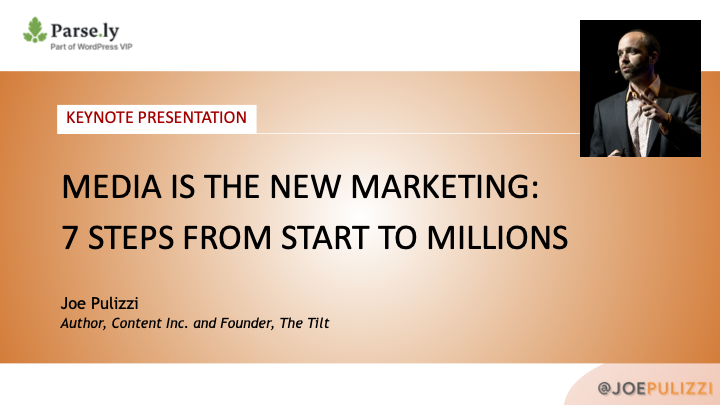
The past two years have been a true test of businesses’ ability to thrive in a world of uncertainty, and the ones with the best content were the ones that came out on top.
Last week, Dave Cardiel, VP of Growth Marketing for WordPressVIP and Parse.ly, sat down with Joe Pulizzi, founder of The Tilt and Content Marketing Institute and author of the Amazon #1 Marketing Bestseller Content Inc., to discuss the keys to building a successful content strategy.
In this webinar, Joe walked us through the seven steps on how any business with any budget can build a digital audience that leads to multiple forms of revenue. Here’s what we learned:
Joe Pulizzi:
Today, I’m going to go through these seven steps, and I’m hoping that there’s at least one thing you can take and integrate into your organization, your marketing, your content creation, and then in your business model.
This model is called the Content Model, because it’s been used by the leading media companies and the best content marketing programs on the planet. You look at Financial Times, you look at New York Times, you look at Red Bull media house on the content marketing side, and Informa or Disney on the big media side, this is the model that they’ve used.
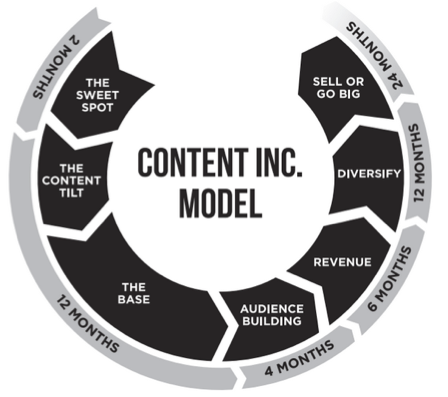
Because they’ve gotten so big and so successful, sometimes we forget how they actually started to build an audience, and then monetize that audience and become the companies they are today.
We have to take a step back and really look at the strategy. When you look at building an audience that knows, likes, and trusts you, and that you can monetize, every one of us starts with the sweet spot.
1. The sweet spot
Think about the audience that you’re trying to target, that specific audience, the customer that you want, and try to identify your sweet spot to figure out what stories you’re going to tell. Your sweet spot should fall between your expertise, your skills and knowledge, and what your audience desires.
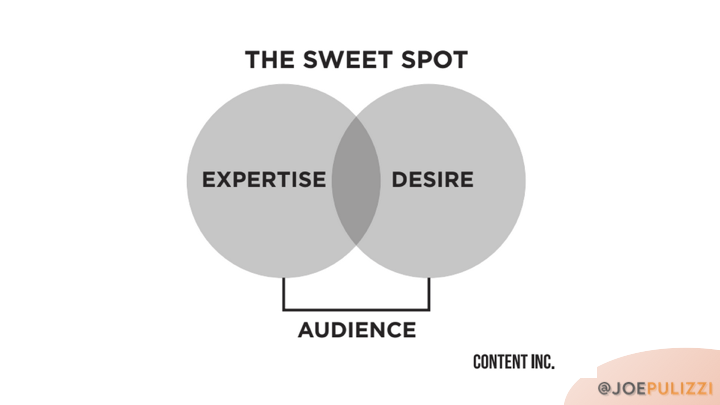
So, first, go through and list as an organization what the knowledge areas are that set you apart. What are your special skills that set you apart as an organization?
Then spend some time on your audience’s pain points. The best part of social media today is that we can connect with our audience and figure out their pain points, what’s keeping them up at night. What are some things, that we can do to help?
2. The content tilt
Now comes the content tilt. This is the most important thing that few organizations actually do.
Here’s an example: Let’s say you go to your favorite search engine and type in “Cloud Computing.” What you’ll find are examples from AWS, Oracle, Microsoft, Salesforce, IBM, and a host of other companies that have billion dollar budgets. You’ll realize that it’s all the same information.
This is the major flaw in basic corporate content marketing. You’ve got to get away from this type of identical content and, instead, think about how your content can be different. That’s where we come up with the concept called the content tilt.
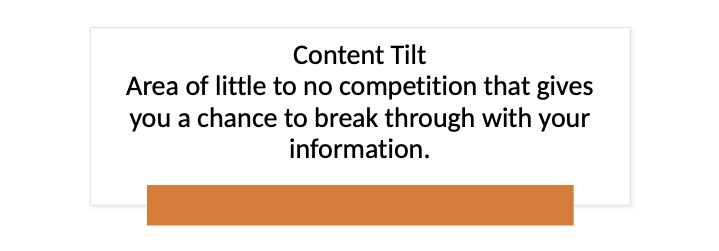
There’s an overwhelming amount of content out there, and it’s tough to cut through all that clutter, so we need to find an area of little to no competition that we can actually break through and build an audience that knows and trusts us.
A few years ago, I was working with a very large technology company that had one blog where they created six posts a day. They were creating so much content with so much frequency, but they were having trouble building an audience of subscribers.
I identified their problem when I found out that they were targeting 18 different audiences with that one blog.
You can’t be the leading expert on one content initiative with 18 audiences. You’re up against media companies, individual content entrepreneurs, and niche brands that are going to beat you every day on it.
So you have to focus, and position stories differently depending on which audience you’re targeting. In this case, this company needed to create 10 or 12 specialized blogs, instead of just one.
3. The base
Now we need to start thinking about Where are we going to tell these stories? What makes the most sense? That is the base.
The greatest media companies of all time started out by focusing on one platform. The biggest problem that companies are having, outside of not having that content tilt, is that they diversify way too quickly.
A lot of companies diversify almost immediately. We’re going to do a podcast. We’re going to do a video series. We’re going to produce original content on Twitter, LinkedIn, Facebook, Instagram, and TikTok.
If you’re spreading yourselves so thin, all you’re going to do is create mediocre content. It’s not going to work.
In any organization we only have a limited amount of what I call content energy. There are only so many things we can focus on at one time.
When you start, you might need to stop doing some things that you’re doing. You don’t have to publish on every one of the available platforms. Define your target audience, determine your differentiation, and then start with one main content type on one or two platforms.
Then you need to show up on time every time, and when you do, you’ve got to be interesting. You have to deliver amazing content on a consistent basis.
Think about when we used to get a newspaper every day. If the newspaper didn’t come in the morning, what happens? People find somewhere else to get their information and maybe never come back.
4. Audience building
Then we get into audience building. What I’m going to say about this is be careful of rented channels. Think about your company’s Facebook page. You might have a million plus followers, but those followers really belong to Facebook.
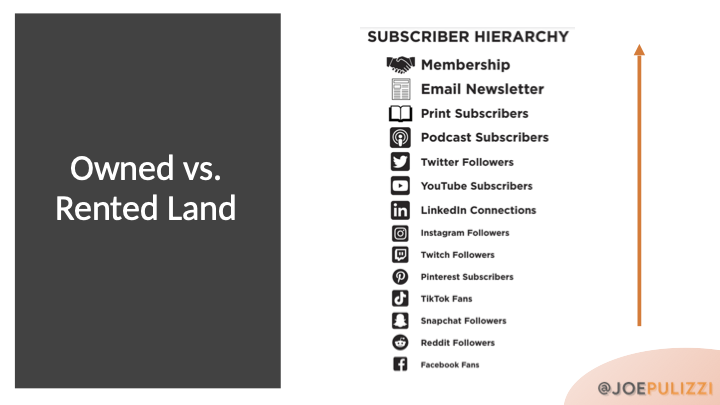
We have to think about the platforms we use as owned versus rented land. If you build your audience on Instagram, or build it on Tiktok or on Youtube, you have to have a strategy to move that audience back to your own channels at some point.
These platforms can change their algorithms and change their rules at anytime. It’s their prerogative, they’re private, they can do whatever they want.
There’s nothing wrong with starting your base on a social platform, but you have to find ways to move that audience into platforms that you can control, platforms where you get that first-party data, like blogs and e-mail newsletters.
We’ve seen an amazing movement in e-mail, and companies—especially media companies, who are focusing on segmented e-mail lists are the ones that have won this whole battle.
5. Revenue
Then, you want to get to the revenue side as quickly as you can. Whether you’re a media professional or a marketing professional, you’ll have the same model because media is marketing.
Once you build a loyal audience, you can start to generate revenue. There are six direct and four indirect revenue streams for content:
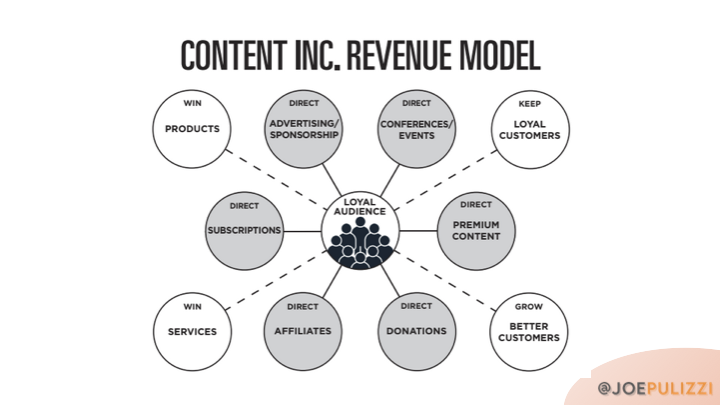
Once you build your audience, you can advertise through a non-competitive partner with something like a banner or a button, or a sponsored webinar like the one we’re talking about now.
Conferences and events are another option. You’ve got a company like Salesforce and their Dreamforce conference, which is one of the biggest events on the planet every year in terms of revenue.
You might also sell books, e-books, or audio books, ask for donations like Wikipedia or Mother Jones, include affiliate marketing in your podcasts or newsletters, or generate revenue through content subscriptions, which you’re seeing a lot of media companies do today.
Then, of course, you’ve got traditional content marketing revenue.
Content marketing is a marathon, not a sprint, and it takes generally about 18 months to build an audience that’s at a point where you can monetize it.
We did a study at thetilt.com, and found that it takes content marketing programs, on average, nine months to make their first dollar, 18 months to add headcount to their team, and 26 months to become financially sustainable.
6. Diversify
So we’ve built that audience, hopefully, on our own platform where we can control first-party data, we’re trying all kinds of monetization strategies, and now we’re in diversification mode.
There’s a good example from Sony Alpha Universe, targeting people that love photography. They started with a blog, built an audience around the blog, then began to diversify into a podcast, on-site events in small photography stores, and finally into their own paid trainings called “alpha sessions.”
They’re ultimately in it for camera sales, but they’re generating profit off of the trainings and events as well.
7. Sell or go big
Finally, if you’re a media company or a content creator, you can ultimately start thinking about selling. If you’ re a brand that has a marketing department and you’re doing content marketing, your ultimate goal could be going big.
Our perception is that some companies are media companies, and some are product and service companies, but that’s not the truth anymore. Today, media is marketing. When it comes to content creation, we’re all doing the same thing. We all have the same opportunities for revenue generation.
My recommendation is this, and if you’re reading this you’re already doing a lot of it: Make the choice—How serious are you going to be?
There’s no dabbling in content. You can’t just dabble in a blog and be OK. Today, you need to be delivering quality content consistently and focusing on the one or two platforms that you can be amazing at. That means you probably have to make a decision to get off some platforms to free up some of your resources.
These are the four things that I would recommend that you do right now.
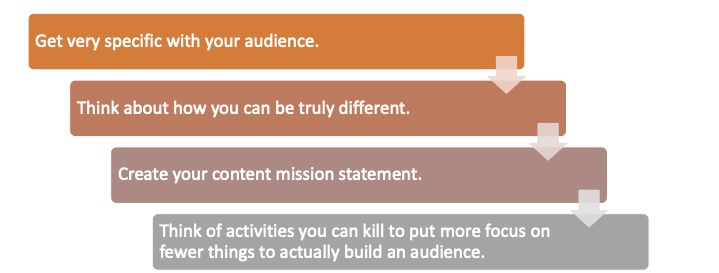
If you’re thinking about improving your content program, focus more specifically on who your audience is and needs to be.
Think about your content and see how can you truly differentiate your message and your story.
Do that through your content category, your audience, and the platforms you use, something to differentiate in some way.
Take another look at your content mission statement. You should have one for each of your content brands and each of your audiences.
And again, my biggest recommendation: stop doing too much stuff. You’ve created a mountain of content. Do a basic content audit of what you’re doing and the things that aren’t making an impact on your business or your audience. I would absolutely stop doing those things. Remember, less is more.
Check out the rest of the webinar to learn more about Joe’s seven steps to building a successful content strategy, or chat with one of our content analytics experts here at Parse.ly about how we can help.